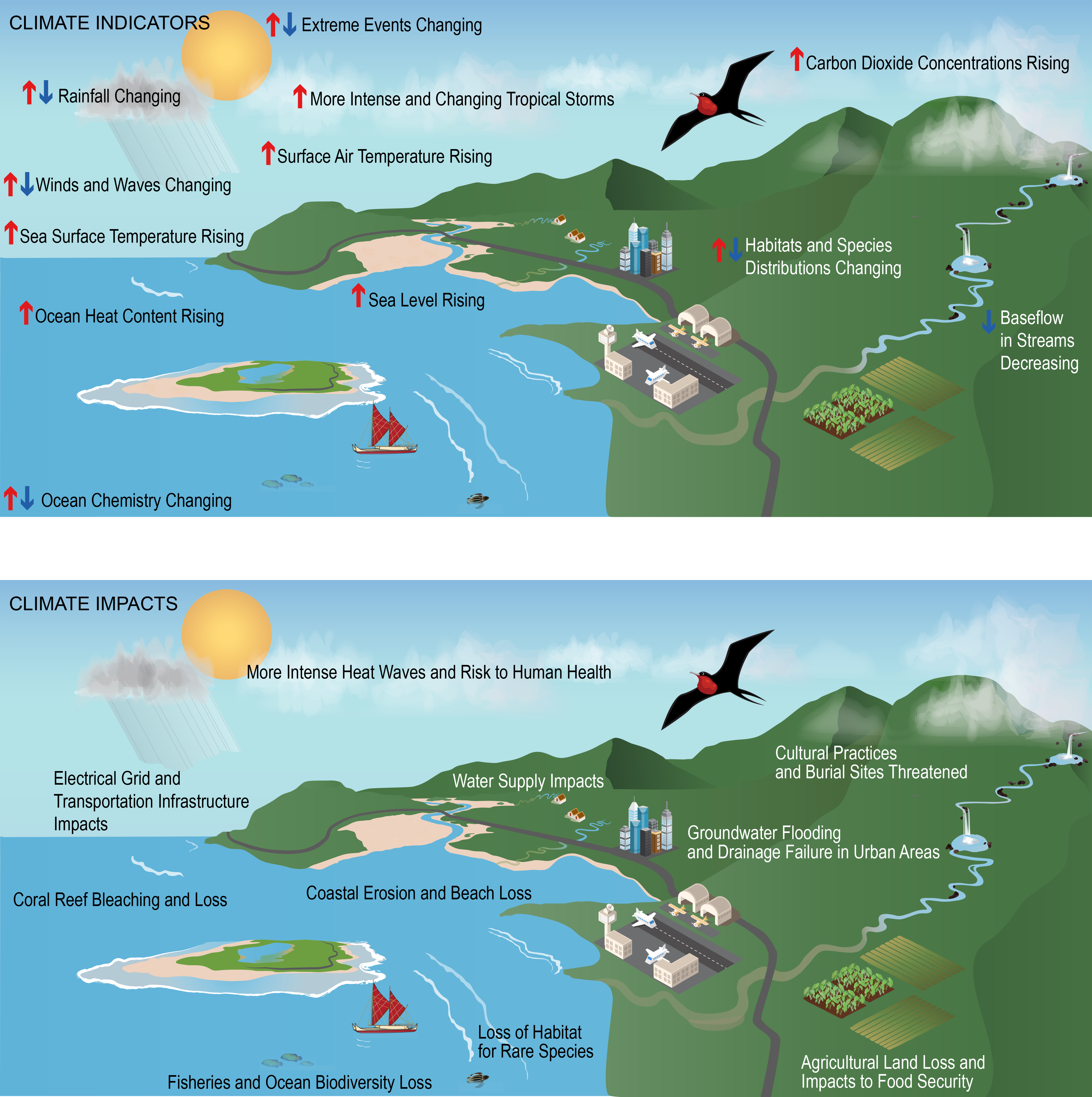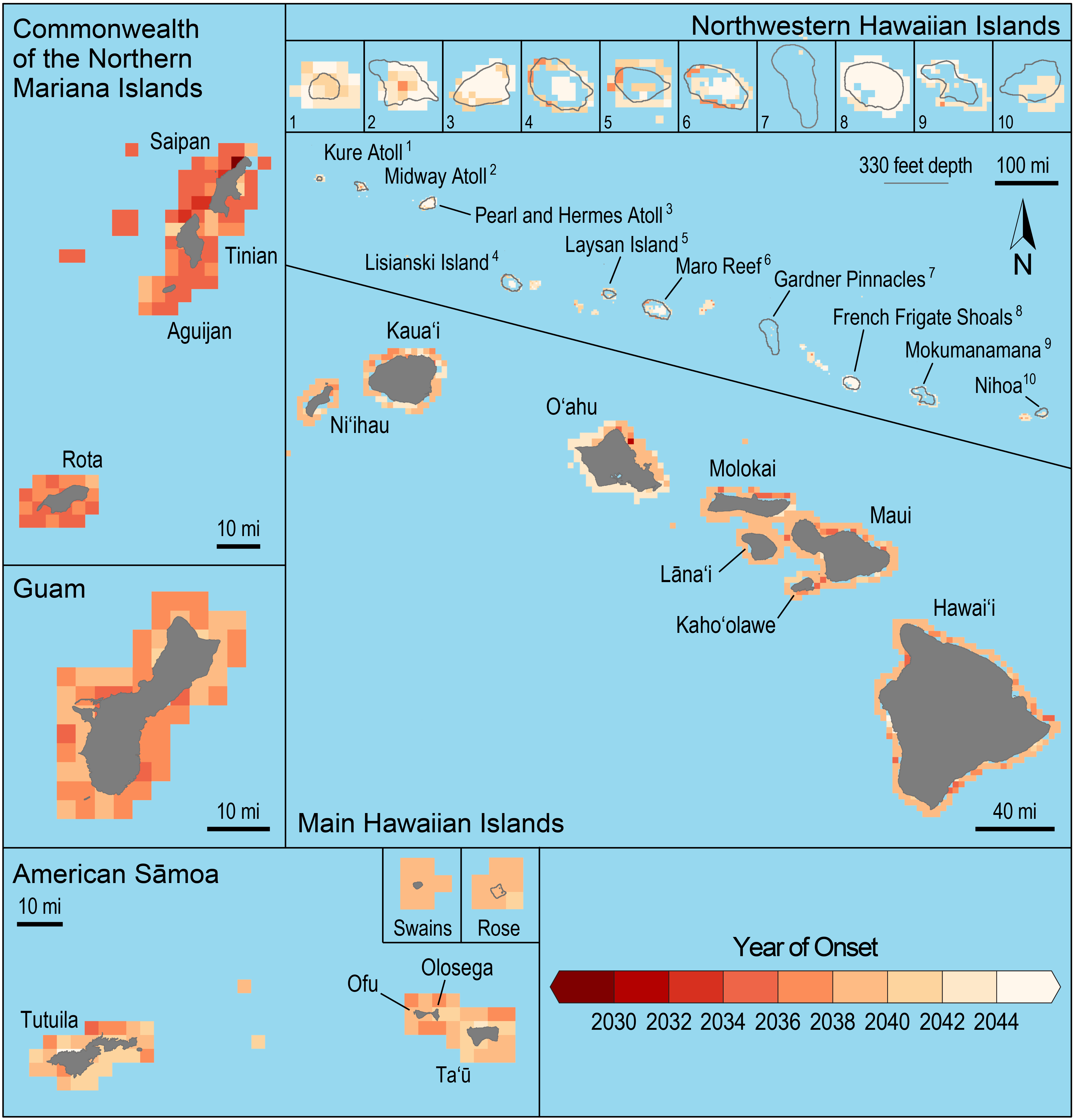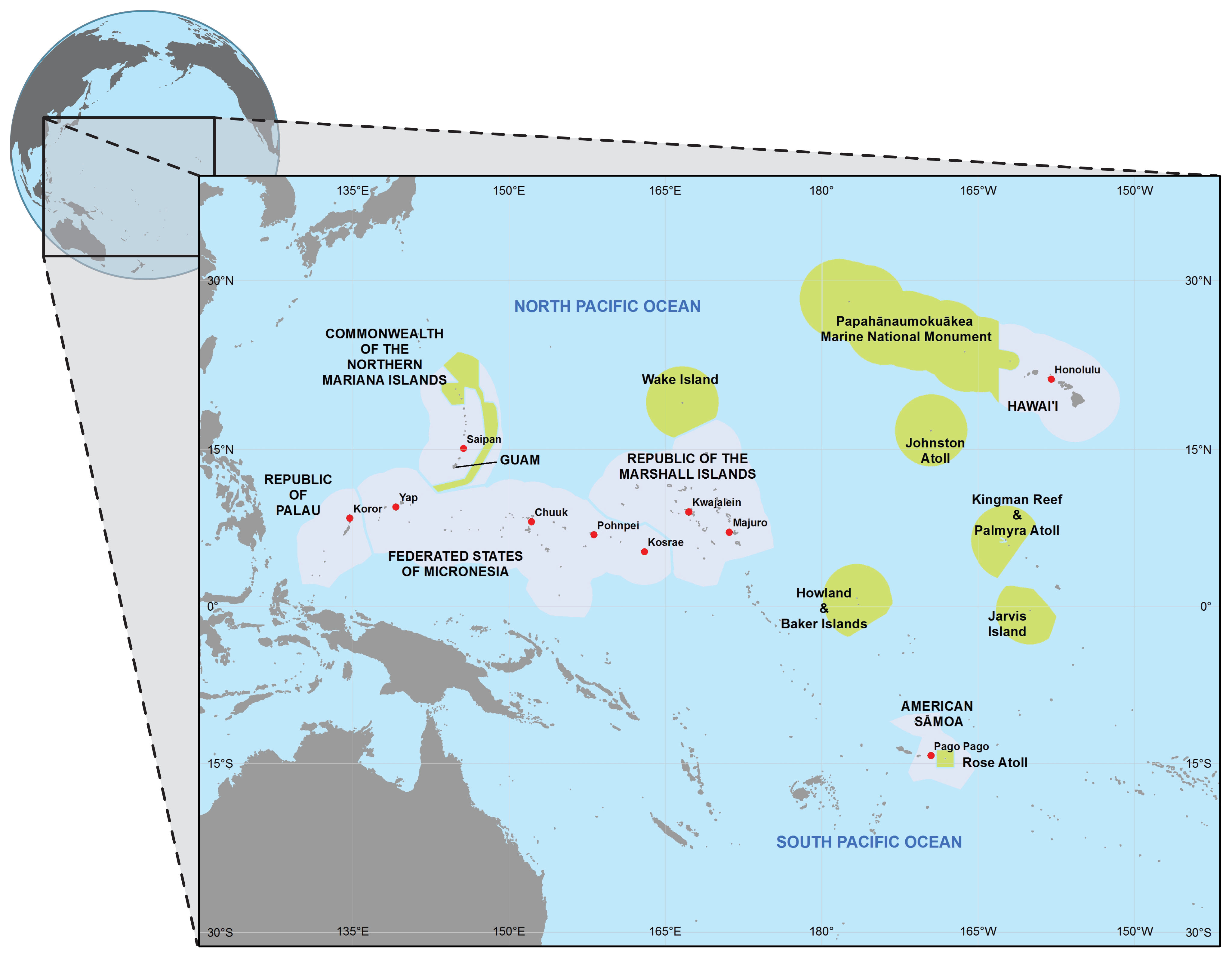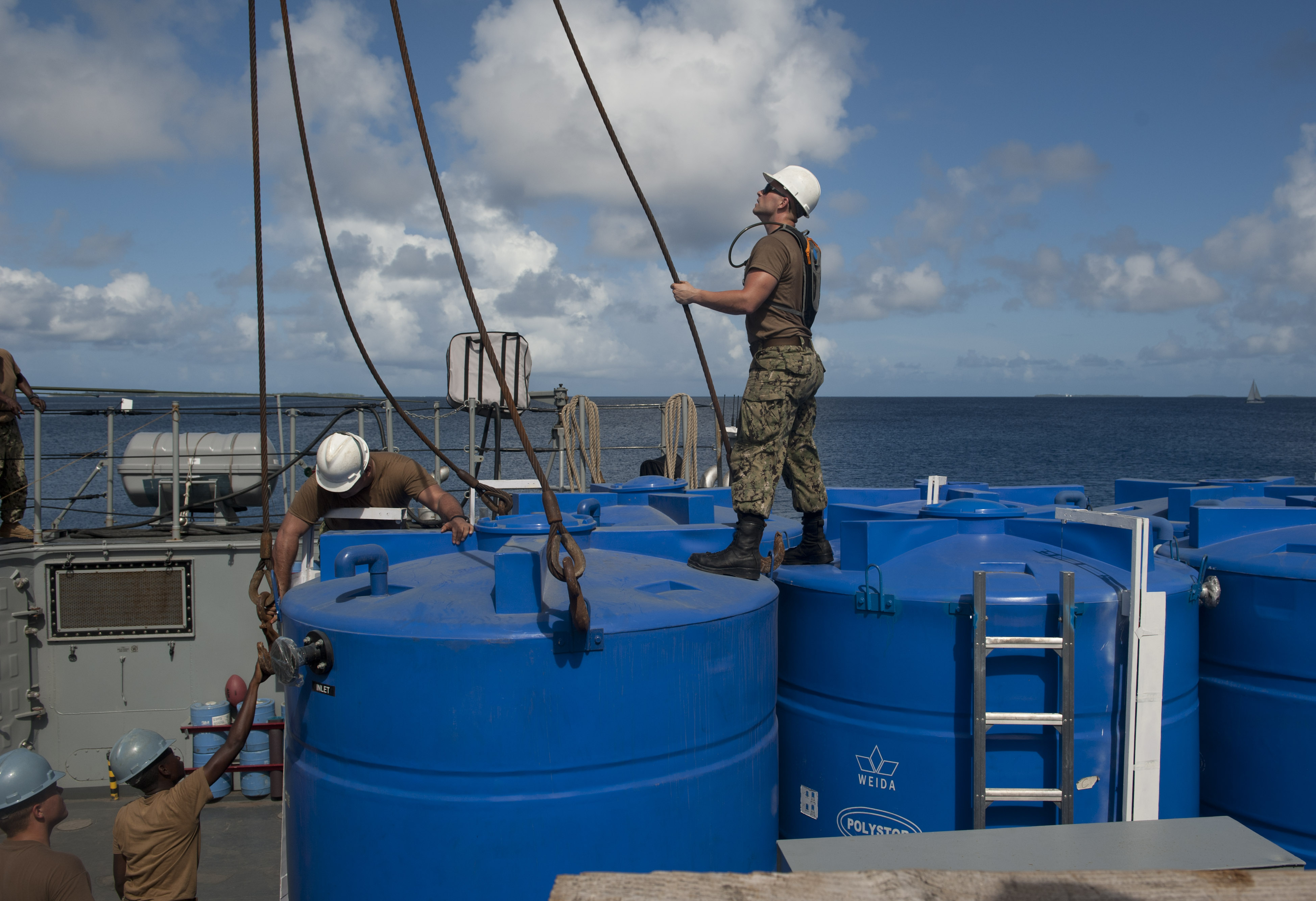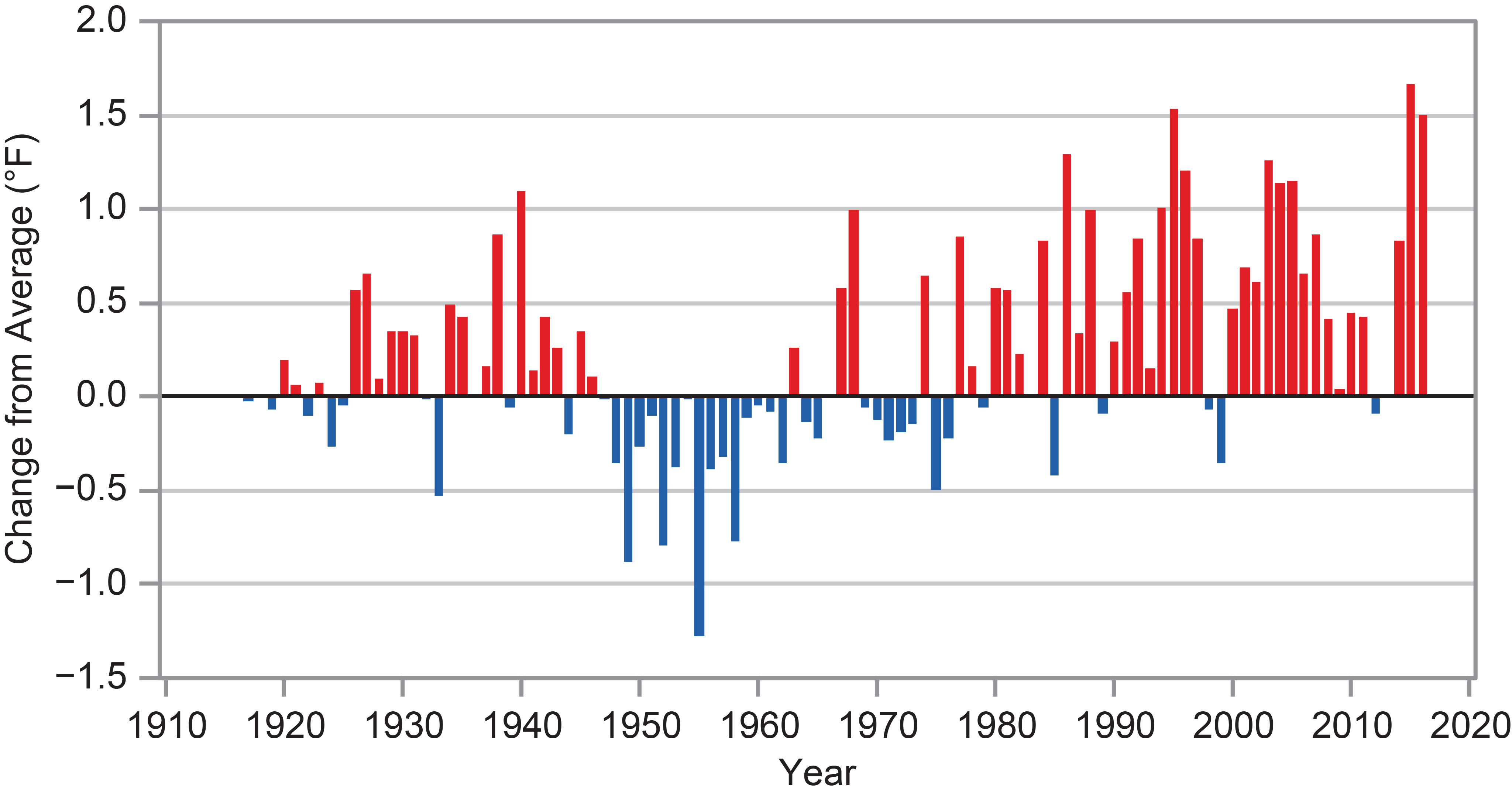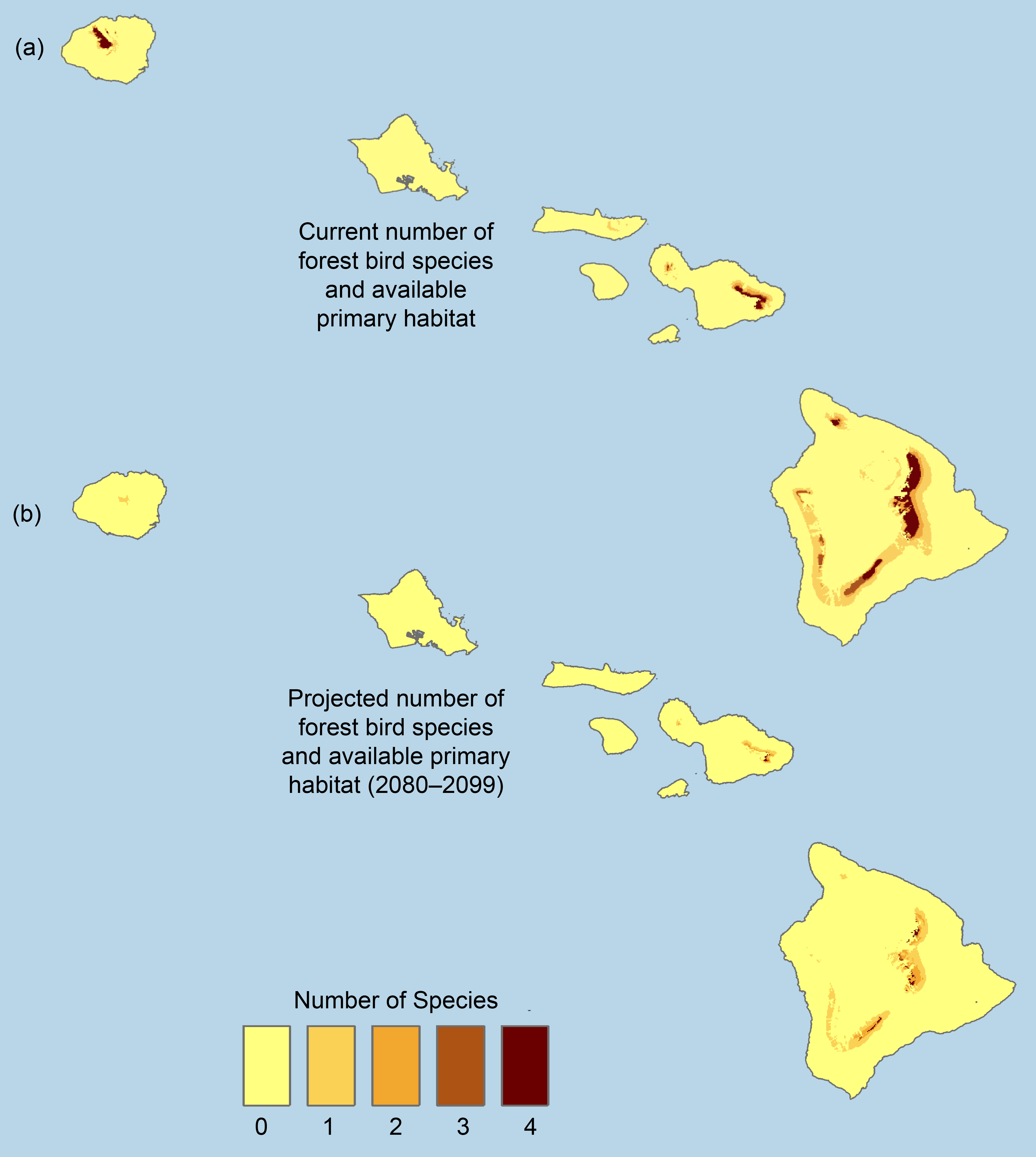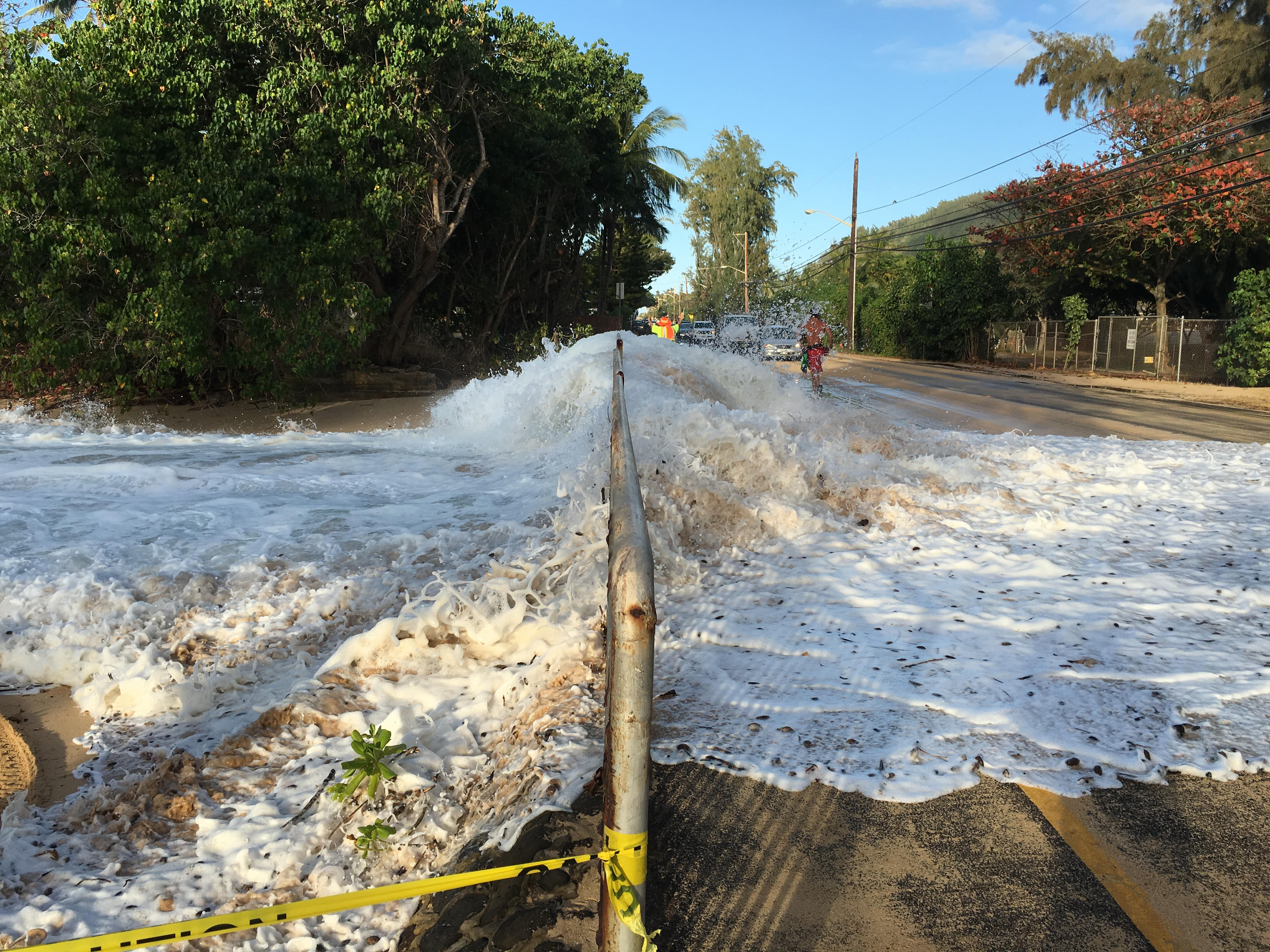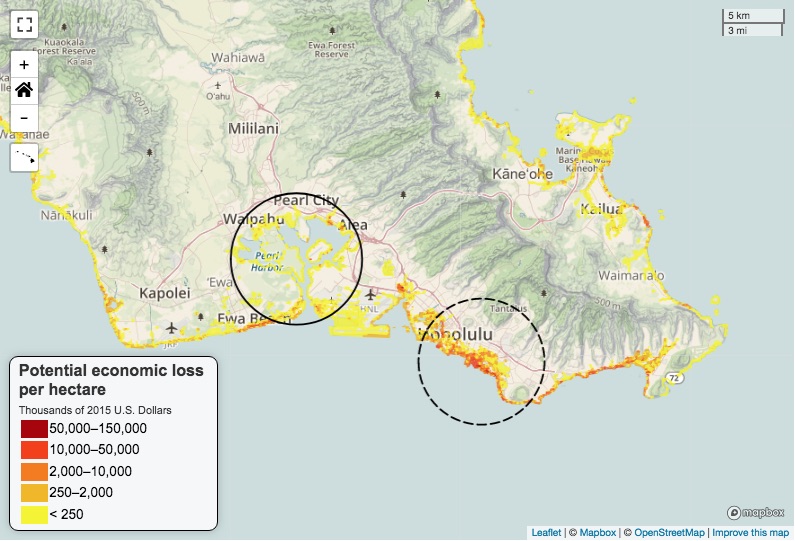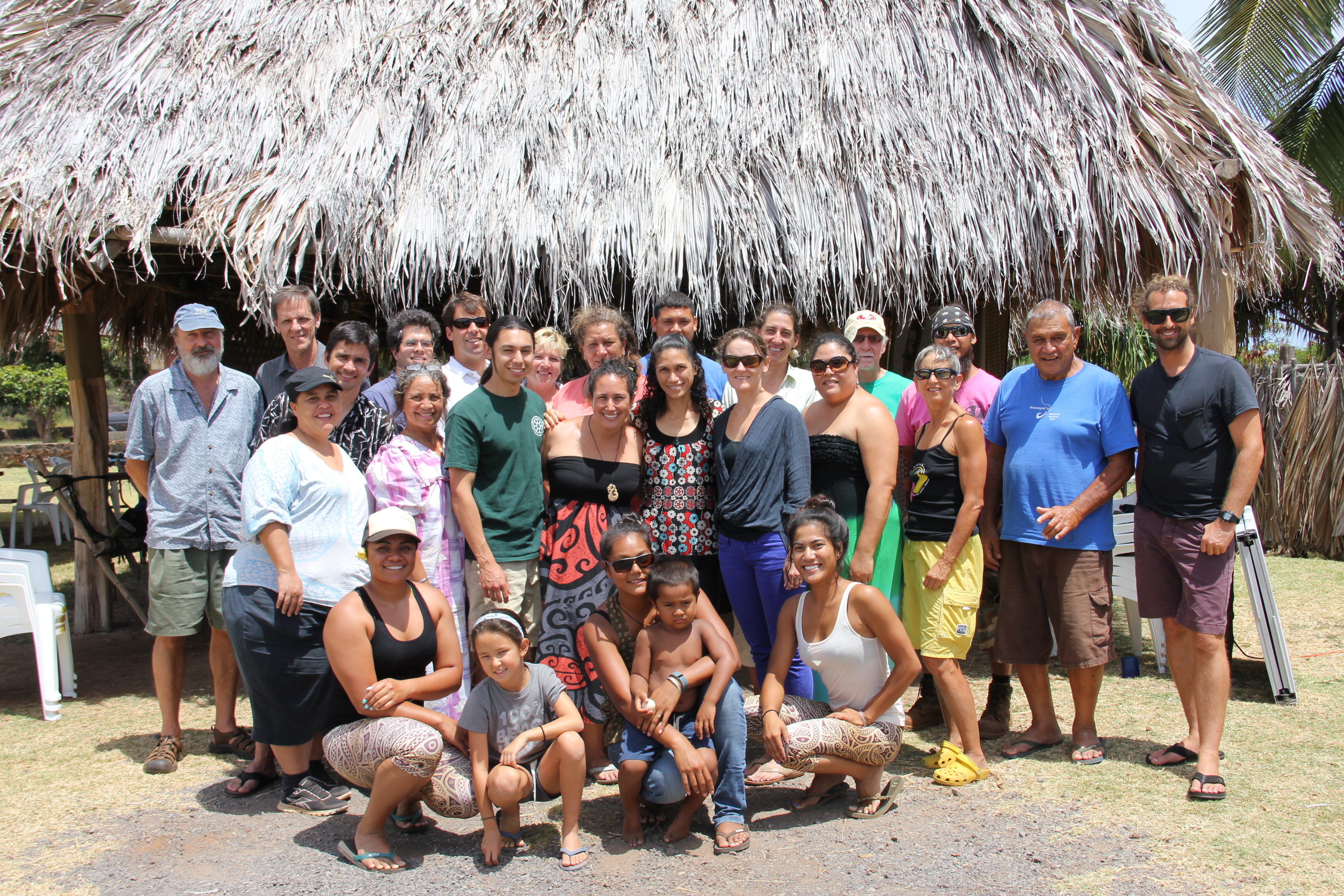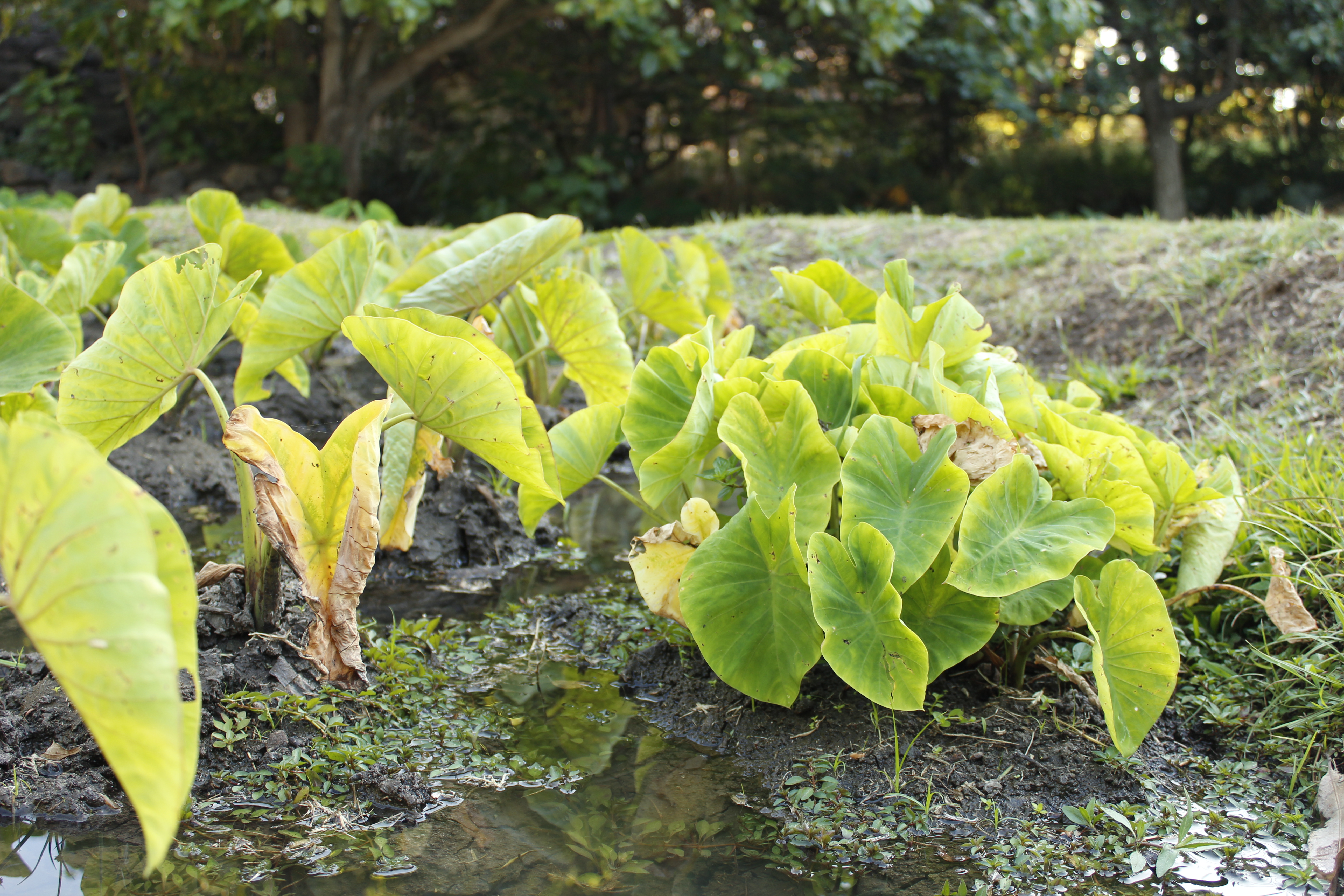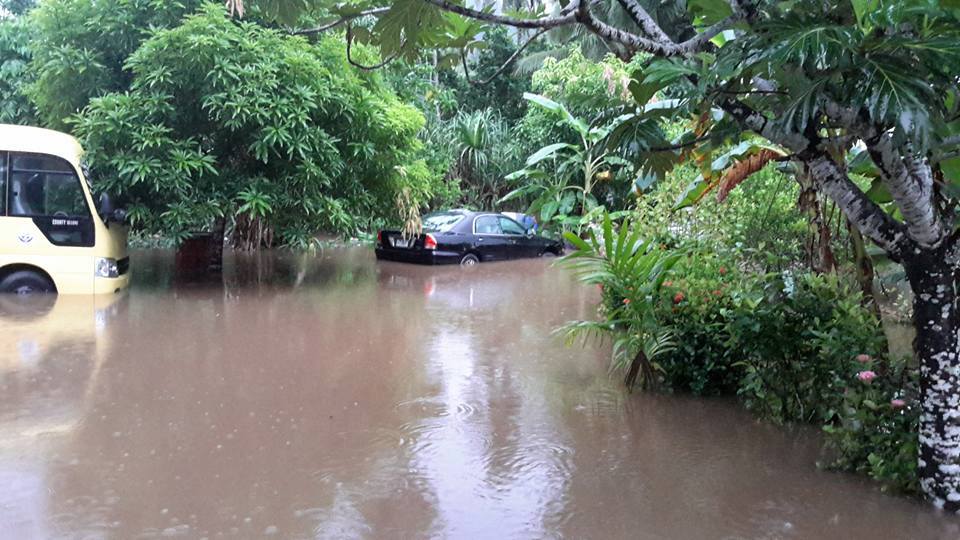To frame this chapter, the regional leads wanted to maximize inclusiveness and represent the key sectoral interests of communities and researchers. To select sectors and a full author team, the coordinating lead author and regional chapter lead author distributed an online Google survey from September to October 2016. The survey received 136 responses representing Hawaiʻi and all the U.S.-Affiliated Pacific Islands (USAPI) jurisdictions; respondents identified which of the National Climate Assessment (NCA) sectors they were most interested in learning about with respect to climate change in the Pacific Islands and suggested representative case studies.223 The five top sectors were picked as the focus of the chapter, and a total of eight lead authors with expertise in those sectors were invited to join the regional team. To solicit additional participation from potential technical contributors across the region, two informational webinars spanning convenient time zones across the Pacific were held; 35 people joined in. The webinars outlined the NCA history and process, as well as past regional reports and ways to participate in this Fourth National Climate Assessment (NCA4).
A critical part of outlining the chapter and gathering literature published since the Third National Climate Assessment (NCA3)224 was done by inviting technical experts in the key sectors to participate in a half-day workshop led by each of the lead authors. A larger workshop centered on adaptation best practices was convened with participants from all sectors, as well as regional decision-makers. In all, 75 participants, including some virtual attendees, took part in the sectoral workshops on March 6 and 13, 2017. Finally, to include public concerns and interests, two town hall discussion events on March 6 and April 19, 2017, were held in Honolulu, Hawaiʻi, and Tumon, Guam, respectively. Approximately 100 participants attended the town halls. Throughout the refining of the Key Messages and narrative sections, authors met weekly both via conference calls and in person to discuss the chapter and carefully review evidence and findings. Technical contributors were given multiple opportunities to respond to and edit sections. The process was coordinated by the regional chapter lead and coordinating lead authors, as well as the Pacific Islands sustained assessment specialist.
Key Message 1: Threats to Water Supplies
Dependable and safe water supplies for Pacific island communities and ecosystems are threatened by rising temperatures (very high confidence), changing rainfall patterns (low confidence), sea level rise (very high confidence), and increased risk of extreme drought and flooding (medium confidence). Islands are already experiencing saltwater contamination due to sea level rise, which is expected to catastrophically impact food and water security, especially on low-lying atolls (medium confidence). Resilience to future threats relies on active monitoring and management of watersheds and freshwater systems.
Description of evidence base
Vulnerability of water supplies to climate change: With their isolation and limited land areas, Hawai‘i and the USAPI are vulnerable to the effects of climate change on water supplies.72,225 Ongoing and projected changes in temperature and precipitation will have negative effects on water supplies in Hawai‘i and some parts of the USAPI. For example, stream low flow and base flow in Hawai‘i decreased significantly over the period 1913–2008, which is at least partly explained by a decline in precipitation.
Temperature change: In Hawai‘i, air temperature increased by 0.76°F (0.42°C) over the past 100 years. The year 2015 was the warmest on record at 1.43°F (0.79°C) above the 100-year average. Mean and minimum (nighttime) temperatures both show long-term, statistically significant increasing trends, while the diurnal temperature range (the average difference between daily minimum and maximum temperature) shows a long-term, statistically significant decreasing trend.59 Estimates of historical temperature changes in Hawai‘i are based on the relatively few observing stations with long records and represent the best available data. Further temperature increases in the Hawai‘i–USAPI region are highly likely. Northern tropical Pacific (including Micronesia) sea level air temperatures are expected to increase by 2.2°–2.7°F (1.2°–1.5°C) by mid-century and by 2.7°–5.9°F (1.5°–3.3°C) by 2100.63 Southern tropical Pacific (including American Sāmoa) sea level air temperatures are expected to increase by 1.8°–3.1°F (1.0°–1.7°C) by mid-century and by 2.5°–5.8°F (1.4°–3.2°C) by 2100.63 Increasing temperatures throughout the Hawai‘i–USAPI region might cause increases in potential evapotranspiration,226 with consequent negative impacts on water supplies.
Precipitation change: While Hawai‘i precipitation has experienced upward and downward changes across a range of timescales, more than 90% of the state had a net downward rainfall trend during 1920–2012.60 Projections of future precipitation changes in Hawai‘i are still uncertain. Using a dynamical downscaling approach to project climate changes in Hawai‘i for the 20-year period at the end of the this century under a middle-of-the-road scenario (SRES A1B) resulted in increases in mean annual rainfall of up to 30% in the wet windward areas of Hawaiʻi and Maui Islands and decreases of 40% in some of the dry leeward and high-elevation interior areas.34 Somewhat different results were obtained using an independent statistical downscaling method.34 For the lower scenario (RCP4.5), mean annual rainfall in Hawai‘i is projected by statistical downscaling to have only small changes in windward areas of Hawai‘i and Maui Islands, to decrease by 10%–20% in windward areas of the other islands, and to decrease by up to 60% in leeward areas for the period 2041–2070. For the same scenario, the late-century (2071–2100) projection is similar to the 2041–2070 projection, except that a larger portion of the leeward areas will experience reductions of 20%–60%. For the higher scenario (RCP8.5), windward areas of Hawai‘i and Maui Islands will see changes between +10% and −10%, and rainfall in leeward areas will decrease by 10% to more than 60% by the 2041–2070 period. By the late-century period (2071–2100), windward areas of Hawai‘i and Maui Islands will see increases of up to 20%, windward areas on other islands will have decreases of 10% to 30%, and leeward areas will have decreases of 10% to more than 60%. The number of climate and water resources monitoring stations has declined across the region,23,76,77 reducing the ability of researchers to project future changes in climate.
Trends in hydrological extremes in Hawai‘i: Increasing trends in extreme 30-day rainfall and the lengths of consecutive dry-day and consecutive wet-day periods66 indicate that Hawai‘i’s rainfall is becoming more extreme and suggest that both droughts and floods are becoming more frequent in Hawai‘i. With the addition of more years of observed data, and a more detailed spatiotemporal analysis from a grid-box level down to the island level, this contrasts with the earlier findings of a decreasing trend in the number of extreme rainfall events in Hawai‘i.227
Saltwater contamination due to sea level rise: Sea level rise exacerbates the existing vulnerability of groundwater lenses on small coral islands to contamination by saltwater intrusion by amplifying the impacts of freshwater lens-shrinking droughts and storm-related overwash events.69
Major uncertainties
Effects of warming on evapotranspiration: There are uncertainties in how warming will affect cloud cover, solar radiation, humidity, and wind speed. All of these affect potential evapotranspiration and changes in soil moisture, and the effects will differ by region.228
Future precipitation changes: Global models differ in their projections of precipitation changes for the Hawai‘i–USAPI region.63 For Hawai‘i, downscaled projections differ according to the choice of global model time horizon, emissions scenario, and downscaling method.229
Description of confidence and likelihood
There is very high confidence in further increases in temperature in the region, based on the consistent results of global climate models showing continued significant increases in temperature in the Hawai‘i–USAPI region for all plausible emissions scenarios.
There is low confidence regarding projected changes in precipitation patterns, stemming from the divergent results of global models and downscaling approaches and from uncertainties around future emissions. However, for leeward areas of Hawai‘i and the eastern part of the Federated States of Micronesia (FSM), future decreases in precipitation are somewhat more likely, based on greater agreement between downscaling approaches for Hawai‘i and greater agreement among global models for eastern FSM.
There is very high confidence in future increases in sea level, based on widely accepted evidence that warming will increase global sea level, with amplified effects in the low latitudes.
There is medium confidence in the increasing risk of both drought and flood extremes patterns, based on both observed changes (for example, increasing lengths of wet and dry periods) and projected effects of warming on extreme weather globally.
There is medium confidence in possible future catastrophic impacts on food and water security resulting from saltwater contamination in low atolls due to sea level rise; this is based on very high confidence in continuing sea level rise, the known effects of saltwater contamination on water supply and agriculture, and uncertainty regarding the effectiveness of adaptation measures.
Key Message 2: Terrestrial Ecosystems, Ecosystem Services, and Biodiversity
Pacific island ecosystems are notable for the high percentage of species found only in the region, and their biodiversity is both an important cultural resource for island people and a source of economic revenue through tourism (very high confidence). Terrestrial habitats and the goods and services they provide are threatened by rising temperatures (very likely, very high confidence), changes in rainfall (likely, medium confidence), increased storminess (likely, medium confidence), and land-use change (very likely, very high confidence). These changes promote the spread of invasive species (likely, low confidence) and reduce the ability of habitats to support protected species and sustain human communities (likely, medium confidence). Some species are expected to become extinct (likely, medium confidence) and others to decline to the point of requiring protection and costly management (likely, high confidence).
Description of evidence base
Projections of sea level rise have been made at both regional and local scales (see Traceable Account for Key Message 3). Based on these projections, the effects of sea level rise on coastal ecosystems have been evaluated for the Northwest Hawaiian Islands.18,83,84,86,171,228 There has also been an assessment of the effects of climate change to many small islands across the Pacific Islands region.70 The effect of sea level rise (and global warming) on mangroves has also been evaluated.86,230,231,232
Forecasts of how climate change will affect rainfall and temperature in the main Hawaiian Islands have been based on both statistical and dynamical downscaling of global climate models (GCMs; see Traceable Account for Key Message 1). Statewide vulnerability models have been developed for nearly all species of native plants233 and forest birds,43 showing substantial changes in the available habitat for many species. More detailed modeling within Hawaiʻi Volcanoes National Park has suggested that rare and listed plants being managed in Special Ecological Areas will experience climate changes that make the habitat in these areas unsuitable.91
Effects of climate change on streamflow in Hawaiʻi will largely be driven by changes in rainfall, although geologic conditions affect the discharge of groundwater that provides base flow during dry weather.234 A regional watershed model from the windward side of Hawaiʻi Island suggested that control of an invasive tree with high water demand would somewhat mitigate decreases in streamflow that might be caused by a drier climate.44 Finally, it has been suggested that ocean acidification will decrease the viability of the planktonic larvae of native Hawaiian stream fishes.99
Major uncertainties
The timing and magnitude of sea level rise are somewhat uncertain. There is greater uncertainty on how climate change will affect the complex patterns of precipitation over the high islands of Hawaiʻi. There is also high uncertainty about how plants will respond to changes in their habitats and the extent to which climate change will foster the spread of invasive species.
Description of confidence and likelihood
It is very likely that air and water temperatures will increase and that sea level will rise (very high confidence). Research indicates that global mean sea level rise will exceed previous estimates and that, in the USAPI, sea level rise is likely to be higher than the global mean (likely, high confidence). As a result, it is likely that climate change will affect low-lying and coastal ecosystems in Hawaiʻi and other Pacific islands, with medium confidence in forecasts of the effects on these ecosystems.
There is low confidence as to how rainfall patterns will shift across the main Hawaiian Islands. It is considered likely that changes in rainfall will result in ecologic shifts expected to threaten some species. However, there is low confidence in specific ecologic forecasts because the direction and magnitude of rainfall changes are uncertain, and there is a lack of robust understanding of how species will respond to those changes. It seems as likely as not that the responses of terrestrial biomes and species to climate change will result in additional complexity in the management of rare and threatened species.
Key Message 3: Coastal Communities and Systems
The majority of Pacific island communities are confined to a narrow band of land within a few feet of sea level. Sea level rise is now beginning to threaten critical assets such as ecosystems, cultural sites and practices, economics, housing and energy, transportation, and other forms of infrastructure (very likely, very high confidence). By 2100, increases of 1–4 feet in global sea level are very likely, with even higher levels than the global average in the U.S.-Affiliated Pacific Islands (very likely, high confidence). This would threaten the food and freshwater supply of Pacific island populations and jeopardize their continued sustainability and resilience (likely, high confidence). As sea level rise is projected to accelerate strongly after mid-century, adaptation strategies that are implemented sooner can better prepare communities and infrastructure for the most severe impacts.
Description of evidence base
Multiple lines of research have shown that changes in melting in Greenland,110 the Antarctic,107 and among alpine glaciers,111 as well as the warming of the ocean,113 have occurred faster than expected. The rate of sea level rise is accelerating,103 and the early signs of impact are widely documented.9 Relative to the year 2000, global mean sea level (GMSL) is very likely to rise 0.3–0.6 feet (9–18 cm) by 2030, 0.5–1.2 feet (15–38 cm) by 2050, and 1.0–4.3 feet (30–130 cm) by 2100 (very high confidence in lower bounds; medium confidence in upper bounds for 2030 and 2050; low confidence in upper bounds for 2100).17,105 Future greenhouse gas (GHG) emissions have little effect on projected average sea level rise in the first half of the century, but they significantly affect projections for the second half of the century. Emerging science regarding Antarctic ice sheet stability suggests that, for high emission scenarios, a GMSL rise exceeding 8 feet (2.4 m) by 2100 is physically possible, although the probability of such an extreme outcome cannot currently be assessed. Regardless of pathway, it is extremely likely that GMSL rise will continue beyond 2100 (high confidence).105
Changes in precipitation,235 Pacific sea level,4 climate variability,3 and the unsustainable practices of many human communities among Pacific islands127 all converge to increase the vulnerability of coastal populations135 as climate change continues in the future.55 As sea level rises and average atmospheric temperature continues to increase, wave events37 associated with changing weather patterns140 constitute a growing mechanism for delivering12 damaging saltwater into island aquifer systems,13 ecosystems,129 and human infrastructure systems.17
In Hawaiʻi, studies by the Hawaiʻi Climate Change Mitigation and Adaptation Commission42 reveal that with 3.2 feet of sea level rise, over 25,800 acres of land in the state would be rendered unusable. Some of that land would erode into the ocean, some would become submerged by inches or feet of standing water, and some areas would be dry most of the year but repeatedly washed over by seasonal high waves. Statewide, about 34% of that potentially lost land is designated for urban use, 25% is designated for agricultural use, and 40% is designated for conservation. The loss of urban land is expected to increase pressure on the development of inland areas, including those designated as agricultural and conservation lands. Across the state, over 6,500 structures located near the shoreline would be compromised or lost with 3.2 feet of sea level rise. Some of these vulnerable structures include houses and apartment buildings, and their loss would result in over 20,000 displaced residents in need of new homes. The value of projected flooded structures, combined with the land value of the 25,800 acres projected to be flooded, amounts to over $19 billion across the state (in 2013 dollars; $19.6 billion in 2015 dollars). However, this figure does not encompass the full loss potential in the state, as monetary losses that would occur from the chronic flooding of roads, utilities, and other public infrastructure were not analyzed in this report and are expected to amount to as much as an order of magnitude greater than the potential economic losses from land and structures. For example, over 38 miles of major roads would be chronically flooded across the state with 3.2 feet of sea level rise. Utilities, such as water, wastewater, and electrical systems, often run parallel and underneath roadways, making lost road mileage a good indication of the extent of lost utilities. This chronic flooding of infrastructure would have significant impacts on local communities as well as reverberating effects around each island.
The loss of valuable natural and cultural resources across all islands would cost the state dearly, due to their intrinsic value. Beaches that provide for recreation, wildlife habitat, and cultural tradition would erode, from iconic sites such as Sunset Beach on O‘ahu to neighborhood beach access points rarely visited by anyone except local residents. Some beaches would be lost entirely if their landward migration is blocked by roads, structures, shoreline armoring, or geology. The flooding of the more than 2,000 on-site sewage disposal systems with 3.2 feet of sea level rise would result in diminished water quality in streams and at beaches and shoreline recreation areas. The loss of and harm to native species and entire ecosystems would have implications for Hawaiian cultural traditions and practices, which are closely tied to the natural environment. Further, nearly 550 cultural sites in the state would be flooded, and many Hawaiian Home Lands communities would be impacted by flooding. In some cases, inland migration or careful relocation of these natural and cultural resources is expected to be possible. In other cases, the resources are inextricably bound to place and would be permanently altered by flooding.42
Marra and Kruk (2017)142 describe climate trends for the USAPI. Globally and locally, observations of GHG concentrations, surface air temperatures, sea level, sea surface temperature, and ocean acidification show rising trends at an increasing rate. Trends in measures of rainfall, surface winds, and tropical cyclones are not as readily apparent. Patterns of climate variability characterize these measures and tend to mask long-term trends. A lack of high-quality, long-term observational records, particularly with respect to in situ stations, contributes to difficulties in discerning trends. To maintain and enhance our ability to assess environmental change, attention needs to be given to robust and sustained monitoring.
There are consistent subregional changes in the number of days with high winds. The global frequency of tropical cyclones (TCs) appears to be showing a slow downward trend since the early 1970s. In the Pacific region, long-term TC trends in frequency and intensity are relatively flat, with the record punctuated by as many active as inactive years.142
Major uncertainties
Major uncertainties lie in understanding and projecting the future melting behavior of the Antarctic and Greenland ice sheets. To date, new observations attest to melting occurring at higher than expected rates. If this continues to be the case, it is plausible for future sea level rise to exceed even worst-case scenarios. Secondary feedbacks to warming, such as changes in the global thermohaline circulation; shifts in major weather elements, such as the intertropical convergence zone and the polar jet stream; and unexpected modes of heat distribution across the hemispheres risk complex responses in the climate system that are not well understood. Pacific climate variability is a governing element that amplifies many aspects of climate change, such as drought, sea level, storminess, and ocean warming. A number of mechanisms through which climate change might alter Pacific variability have been proposed on the basis of physical modeling, but our understanding of the variability remains low, and confidence in projected changes is also low. For instance, in any given Pacific region, our understanding of future TC occurrence, intensity, and frequency is low. Future physical responses to climate change that have not yet been described are possible. These uncertainties greatly limit our ability to identify the chronology of changes to expect in the future.
Description of confidence and likelihood
There is very high confidence that a continued rise in global temperature will lead to increases in the rate of sea level rise. There is less confidence in the projected amounts of sea level rise during this century, and there is low confidence in the upper bounds of sea level rise by the end of the century. Sea level rise will very likely lead to saltwater intrusion, coastal erosion, and wave flooding. It is very likely this will strain the sustainability of human infrastructure systems, limit freshwater resources, and challenge food availability. If the high-end projections of future sea level rise materialize, it is very likely this will threaten the very existence of Pacific island coastal communities.
Key Message 4: Oceans and Marine Resources
Fisheries, coral reefs, and the livelihoods they support are threatened by higher ocean temperatures and ocean acidification (very likely, high confidence).Widespread coral reef bleaching and mortality have been occurring more frequently, and by mid-century these events are projected to occur annually, especially if current trends in emissions continue (likely, medium confidence). Bleaching and acidification will result in loss of reef structure, leading to lower fisheries yields, and loss of coastal protection and habitat (very likely, very high confidence). Declines in oceanic fishery productivity of up to 15% and 50% of current levels are projected by mid-century and 2100, respectively, under the higher scenario (RCP8.5; likely, medium confidence).
Description of evidence base
The Key Message was developed based on input from an expert working group convened at the outset of this section development and supported by extensive literature.
Ocean warming: NCA3 documented historical increases in sea surface temperature (SST), and current levels in much of the region have now exceeded the upper range of background natural variation.32,154 Future increases are projected even under lower-than-current emissions rates.123,154
Ocean acidification: Atmospheric carbon dioxide levels recorded at Mauna Loa, Hawaiʻi, have recently exceeded 400 parts per million, and oceanic pH levels measured off Oʻahu have steadily declined from an annual average of about 8.11 to 8.07 over the past 25 years (data from Hawaiʻi Ocean Time Series, SOEST, University of Hawaiʻi) and are projected to decrease to 7.8 by 2100.123 As pH declines, it lowers the saturation level of aragonite (the form of calcium carbonate used by corals and many other marine organisms), reducing coral and shell growth.125 By the end of the century, aragonite saturation is projected to decline from a current level of 3.9 to 2.4, representing extremely marginal conditions for coral reef growth.32,123,159,161
Bleaching events: These continue to occur—most recently over successive years—with widespread impacts.45,158 Sea surface temperature time series from a suite of Climate Model Intercomparison Project 5 outputs that are statistically downscaled to 4 km resolution are used to project the year when coral reefs will begin to experience annual bleaching under the higher scenario (RCP8.5).46 These data forecast that bleaching will be an annual event for the region starting in about 2035.46
Mortality: During the 2014–2015 bleaching events, coral mortality in western Hawaiʻi was estimated at 50%45 and over 90% at the pristine equatorial Jarvis Atoll.156
Coral reef ecosystem impacts: Coral reef cover around the Pacific Islands region is projected to decline from the current average level of about 40% to 15%–30% by 2035 and 10%–20% by 2050.123 The loss of coral reef habitat is projected to reduce fish abundance and fisheries yields by 20%.123 Loss of coral reefs will result in increased coastal erosion.23,236 Tourism is the major economic engine in Hawai‘i, and healthy coral reef ecosystems are critical to this economy. Under the higher scenario (RCP8.5), coral reef loss is projected to result in a total economic loss of $1.3 billion per year in 2050 and $1.9 billion per year in 2090 (in 2015 dollars, undiscounted). In 2090, a lower scenario (RCP4.5) would avoid 16% of coral cover loss and $470 million per year (in 2015 dollars, undiscounted) compared to the higher scenario.162 The confidence intervals around these loss estimates under RCP8.5 for 2050 range from a gain of $240 million to a loss of $1.9 billion, and for 2090 range from a loss of $1.7 billion to $1.9 billion (in 2015 dollars, undiscounted).162
Insular fisheries: Insular fishes, including both coral reef fishes and more mobile, coastal pelagics (species such as mahi mahi and wahoo), are impacted both from declines in carrying capacity and loss from migration in response to temperature change. Taken together, declines in maximum catch potential exceeding 50% from late 20th century levels under the higher scenario are projected by 2100 for the exclusive economic zones of most islands in the central and western Pacific.163
Oceanic fisheries: A number of studies have projected that ocean warming will result in lower primary productivity due to increased vertical stratification and loss of biodiversity as organisms move poleward.129,167,169 Estimates of up to a 50% decline in fisheries yields are projected with two different modeling approaches.129,169 The impact of climate change specifically on fisheries targeting bigeye, yellowfin, and skipjack tunas in the western and central equatorial Pacific has been explored with fisheries models.123,237,238 However, there is considerable uncertainty in the projections of population trends, given our lack of understanding of how the various life stages of these species will respond and the sensitivity of the projections to the specific model used.238,239
Major uncertainties
A major uncertainty for coral reefs is whether they can evolve rapidly enough to keep up with the changing temperature and pH.164,165 In the oceanic ecosystem, the impacts of changing ocean chemistry on the entire food web are not well understood but are expected to result in shifts in the composition of the species or functional groups, altering the energy flow to top trophic levels.240,241 For example, a shift in the micronekton community composition (squids, jellyfishes, fishes, and crustaceans) was projected to alter the abundance of food available to fishes at the top of the food web.240 The impact of climate change on the intensity and frequency of interannual and decadal modes of climate variability (such as El Niño–Southern Oscillation and Pacific Decadal Oscillation) is not well known but has very important consequences.1
Description of confidence and likelihood
There is high confidence that fisheries and the livelihoods they support are threatened by warmer ocean temperatures and ocean acidification. Widespread and multiyear coral reef bleaching and mortality are already occurring. It is likely, based on modeled SST projections, that by mid-century, bleaching will occur annually with associated mortality.
There is medium confidence in the projection of annual bleaching by mid-century, as it does not take into account any adaptation in corals.
There is high confidence that bleaching and rising seawater acidity will result in loss of reef structure, leading to lower fisheries yields and loss of coastal protection. This is deemed very likely because significant coral mortality has recently been observed in western Hawaiian coral reefs that suffered from the 2015 bleaching event. Further, the positive relationship between fish density and coral reef cover is well established. The magnitude of this impact depends on the extent that coral species exhibit adaptive or resilience capacity.
There is medium confidence that declines in oceanic fishery productivity of up to 15% and 50% are likely by mid-century and 2100, respectively. These declines are considered likely because we have seen related linkages between climate variability such as ENSO and the Pacific Decadal Oscillation and fisheries yields that provide an analog in some ways to global warming impacts. The uncertainty lies in our limited understanding of the linkages and feedbacks in the very complex oceanic food web. As temperate habitats warm, they will likely gain some tropical species, while the tropical habitats will likely only lose species.
Key Message 5: Indigenous Communities and Knowledge
Indigenous peoples of the Pacific are threatened by rising sea levels, diminishing future freshwater availability, and shifting ecosystem services. These changes imperil communities’ health, well-being, and modern livelihoods, as well as their familial relationships with lands, territories, and resources (likely, high confidence). Built on observations of climatic changes over time, the transmission and protection of traditional knowledge and practices, especially via the central role played by Indigenous women, are intergenerational, place-based, localized, and vital for ongoing adaptation and survival.
Description of evidence base
The research supporting this Key Message examines the impacts of climate change on the lands, territories, and resources of the Pacific region and its Indigenous communities.
It is foundational to highlight the interconnectedness and important familial relationship Indigenous peoples have with their lands, territories, and resources. Native Hawaiian attorneys and professors Sproat and Akutagawa discuss the health impacts and threats that climate change poses for Indigenous communities and their relationship with ancestral resources. Sproat states that “any such loss will result in the loss of culture.”177 Further support is found in a community health assessment done by Akutagawa and others that states, “In traditional Hawaiian conceptions of health, personal harmony and well-being are deemed to stem from one’s relationship with the land, sea, and spiritual world.”176
Governments and their support institutions are also sharing outcomes of projects they’ve initiated over the years that document not only the successes but also the challenges, observations, and lessons learned.149,179 This includes the recognition of the dominant role of Indigenous women in island communities as gatherers and in household activities; economic development activities like transporting and selling produce;146 distribution of crops;179 maintenance of crop diversity, food security, security of income, seed saving, and propagation; transmission of traditional knowledge and practices, especially spiritual practices;185 and stewarding underwater reef patches and stone enclosures as gardens.242
In writing this Key Message, the authors considered the body of research focusing on the impacts of climate change on Pacific communities such as sea level rise,104,115,147,177,243 ocean acidification,84,115,147,177,184 and drought.147,177,179,184,242,243,244 Clear examples used in the studies illustrate the confidence that Indigenous communities are at high risk for experiencing effects at a physical,176,245 social,22,175,176,177,184,244 and spiritual level.21,84,174,175,176,177,245
There is very strong evidence that traditional knowledge is key to the resilience and adaptive capacity of Indigenous peoples of the Pacific.21,84,176,180,184,185,242
Major uncertainties
There is no doubt that Indigenous communities of the Pacific are being impacted by climate change. However, the rate and degree of the impacts on the spiritual, relational, and ancestral connectedness vary from community to community and on the type of practice being impacted. This variable is difficult to document and express in certain circumstances. Additionally, the degree of the impact varies according to the livelihoods of the community and the specific climatic and socioeconomic and political circumstances of the island in question.
Description of confidence and likelihood
There is high confidence that climate change is having far-reaching effects on the land security, livelihood security, habitat security, and cultural food security of Indigenous peoples of the Pacific.
It is likely that most of these impacts will have negative effects on the cultural heritage of the Pacific island communities.
There is high confidence that traditional knowledge together with science will support the adaptive capacity of Pacific island communities to survive on their islands.
Key Message 6: Cumulative Impacts and Adaptation
Climate change impacts in the Pacific Islands are expected to amplify existing risks and lead to compounding economic, environmental, social, and cultural costs (likely, medium confidence). In some locations, climate change impacts on ecological and social systems are projected to result in severe disruptions to livelihoods (likely, high confidence) that increase the risk of human conflict or compel the need for migration. Early interventions, already occurring in some places across the region, can prevent costly and lengthy rebuilding of communities and livelihoods and minimize displacement and relocation (likely, high confidence).
Description of evidence base
For Atlantic and eastern North Pacific hurricanes and western North Pacific typhoons, increases are projected in precipitation rates and intensity. The frequency of the most intense of these storms is projected to increase in the western North Pacific and in the eastern North Pacific (see also Key Message 3).246 Studies indicate that Hawaiʻi will see an increased frequency of tropical cyclones (TCs) due to storm tracks shifting northward in the central North Pacific.40,247
The Climate Science Special Report (CSSR) summarizes extensive evidence that is documented in the climate science literature and is similar to statements made in NCA3 and international106 assessments.33 More recent downscaling studies have further supported these assessments,248 though pointing out that the changes (future increased intensity and TC precipitation rates) will not necessarily occur in all basins.246
Damage from TCs is significant. Tropical Cyclone Evan struck Sāmoa in December 2012 and caused damage and losses of approximately $210 million dollars (dollar year not reported), representing 30% of its annual gross domestic product (GDP). Tropical Cyclone Pam struck Vanuatu, Tuvalu, and Kiribati in 2015; in Vanuatu, it killed 11 people and caused approximately $450 million (dollar year not reported) in damages and losses, equal to 64% of GDP.196
In the CSSR, future relative sea level rise as shown for the 3.3-feet (1 m) Interagency scenario in 2100 indicates that, because they are far from all glaciers and ice sheets, relative sea level rise in Hawai‘i and other Pacific islands due to any source of melting land ice is amplified by the static-equilibrium effects. Static-equilibrium effects on sea level are produced by the gravitational, elastic, and rotational effects of mass redistribution resulting from ice loss.105
Sea level rise across Hawaiʻi is projected to rise another 1–3 feet by the end of this century. Sea level rise has caused an increase in high tide floods associated with nuisance-level impacts. High tide floods are events in which water levels exceed the local threshold (set by the National Oceanic and Atmospheric Administration’s National Weather Service) for minor impacts. These events can damage infrastructure, cause road closures, and overwhelm storm drains. Along the Hawaiian coastline, the number of tidal flood days (all days exceeding the nuisance-level threshold) has also increased, with the greatest number occurring in 2002–2003. Continued sea level rise will present major challenges to Hawaiʻi’s coastline through coastal inundation and erosion. Seventy percent of Hawaiʻi’s beaches have already been eroded over the past century, with more than 13 miles of beach completely lost. Sea level rise will also affect Hawai‘i’s coastal storm water and wastewater management systems and is expected to cause extensive economic impacts through ecosystem damage and losses in property, tourism, and agriculture.247
In the Pacific Islands region, population, urban centers, and critical infrastructure are concentrated along the coasts. This results in significant damages during inundation events. In December 2008, wind waves generated by extratropical cyclones, exacerbated by sea level rise, caused a series of inundation events in five Pacific island nations.9 An area of approximately 3,000 km in diameter was affected, impacting approximately 100,000 people. Across the islands, major infrastructure damage and crop destruction resulted, costing millions of dollars and impacting livelihoods, food security, and freshwater resources.
The increases in the frequency and intensity of climate change hazards, including cyclones, wind, rainfall, and flooding, pose an immediate danger to the Pacific Islands region. A decrease in the return times of extreme events, which will reduce the ability of systems to recover, will likely cause long-term declines in welfare.181 For small islands states, the damage costs of sea level rise are large in relation to the size of their economies.194,195
The social science research on climate and conflict suggests a possible association between climate variability and change and conflict. Consensus or conclusive evidence of a causal link remains elusive. Hsiang et al. (2013)249 find strong causal evidence linking climatic events to human conflict across a range of spatial scales and time periods and across all major regions of the world. They further demonstrate that the magnitude of climate influence is substantial.249 Specifically, large deviations from average precipitation and mild temperatures systematically increase the risk of many types of conflict (intergroup to interpersonal), often substantially. Hsiang and Burke (2014)250 describe their detailed meta-analysis, examining 50 rigorous quantitative studies, and find consistent support for a causal association between climatological changes and various conflict outcomes.250 They note, however, that multiple mechanisms can explain this association and that the literature is currently unable to decisively exclude any proposed pathway between climatic change and human conflict.249
Evidence of the impact of climate on livelihoods is also well established. Barnett and Adger (2003, 2007)191,197 are among a range of studies that conclude that climate change poses risks to livelihoods, communities, and cultures.197 These risks can influence human migration. The United Nations Environment Programme finds that the degree to which climatic stressors affect decisions to migrate depend on a household’s vulnerability and sensitivity to climatic factors.206
Major uncertainties
A key uncertainty remains the lack of a supporting, detectable anthropogenic signal in the historical data to add further confidence to some regional projections. As such, confidence in the projections is based on agreement among different modeling studies. Additional uncertainty stems from uncertainty in both the projected pattern and magnitude of future sea surface temperatures.33,40,248
One study projects an increase in tropical cyclone frequency (TCF) of occurrence around the Hawaiian Islands but stipulates that TCF around the Hawaiian Islands is still very low in a warmed climate, so that a quantitative evaluation of the future change involves significant uncertainties.40
Uncertainties in reconstructed global mean sea level (GMSL) change relate to the sparsity of tide gauge records, particularly before the middle of the twentieth century, and to the use of a variety of statistical approaches to estimate GMSL change from these sparse records. Uncertainties in reconstructed GMSL change before the 20th century also relate to the lack of geological proxies (preserved physical characteristics of the past environment that can stand in for direct measurement) for sea level change, the interpretation of these proxies, and the dating of these proxies. Uncertainty in attribution relates to the reconstruction of past changes and the magnitude of natural variability in the climate.
Since NCA3, multiple approaches have been used to generate probabilistic projections of GMSL rise. These approaches are in general agreement. However, emerging results indicate that marine portions of the Antarctic ice sheet are more unstable than previously thought. The rate of ice sheet mass changes remains challenging to project.
In sea level rise projections, Antarctic contributions are amplified along U.S. coastlines, while Greenland contributions are dampened; regional sea level is projected to be higher than if driven by a more extreme Greenland contribution and a somewhat less extreme Antarctic contribution.17
The degree to which climate variability and change impact conflict, and related causal pathways, remains uncertain. This is compounded by the fact that different types of conflict—social, political, civil, or violent—are conflated.209,251 Violent conflict can describe interpersonal-, intergroup-, and international-level disputes. Some researchers contend that systematic research on climate change and armed conflict has not revealed a direct connection.252 Gemenne et al. (2014)208 argue that there is a lack of convincing empirical evidence or theories that explain the causal connection between climate change and security. They do, however, note that there is some evidence for statistical correlation between climatic changes and conflict, broadly referenced.
Gemenne et al. (2014)208 also note that the relationship between climate change and security comes from observation of past patterns and that present and projected climate change have no historical precedent. In effect, understanding past crises and adaptation strategies will no longer be able to help us understand future crises in a time of significant climate change.
The degree to which climate variability and change affect migration decisions made today also remains uncertain. This is in part due to the diverse scenarios that comprise climate migration, which themselves result from multiple drivers of migration.251 Burrows and Kinney (2016)251 detail examples of climate extremes leading to migration conflicts since 2000, yet they note that there are surprisingly few case studies on recent climate extremes that lead to migration and conflict specifically, despite an increasing body of literature on the theory.
While researchers disagree as to the degree to which climate change drives conflict and migration and the causal pathways that connect them, there is agreement that further research is needed. Buhaug (2015)252 and Gemenne et al. (2014)208 argue for research to develop a more refined theoretical understanding of possible indirect and conditional causal connections between climate change and, specifically, violent conflict.252 Hsiang and Burke (2014)250 would like additional research that reduces the number of competing hypotheses that attempt to explain the overwhelming evidence that climatic variables are one of many important causal factors in human conflict.250 Burrows and Kinney (2016)251 explore the potential pathways linking climate change, migration, and increased risk of conflict and argue that future research should focus on other pathways by which climate variability and change are related to conflict, in addition to the climate–migration–conflict pathway. Kallis and Zografos (2014)209 seek greater understanding of the potential harm of certain climate change adaptation measures that have the potential to result in maladaptation by spurring conflict.
Description of confidence and likelihood
There is medium confidence that climate change will yield compounding economic, environmental, social, and cultural costs. There is greater evidence of these compounding costs resulting from extreme events that are exacerbated by climate change.
There is high confidence that food and water insecurity will result in severe disruptions to livelihoods, including the displacement and relocation of island communities.
It is likely that the absence of interventions will result in the costly and lengthy rebuilding of communities and livelihoods and more displacement and relocation. Events have played out repeatedly across the region and have resulted in damage, disruptions, and displacements.
It is likely and there is very high confidence that direct engagement and partnership with communities will be a critical element of adaptation success, as this has strong evidence and high consensus in the literature; however, there are a limited number of publications that document this partnership model in Alaska.
